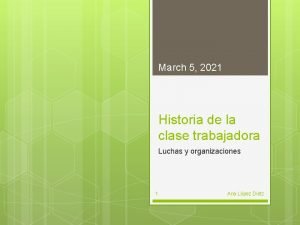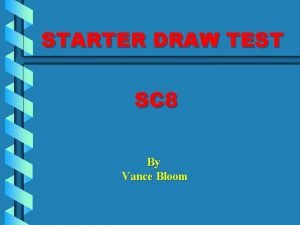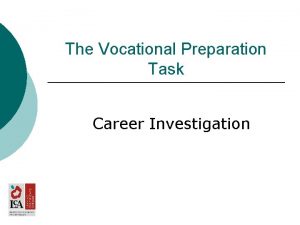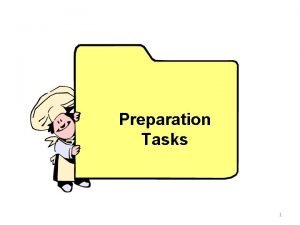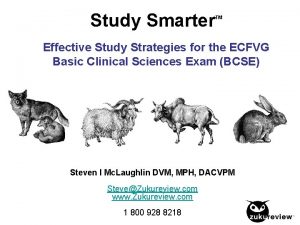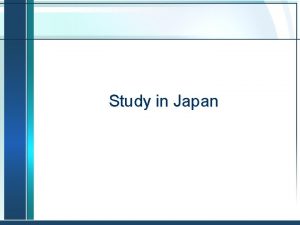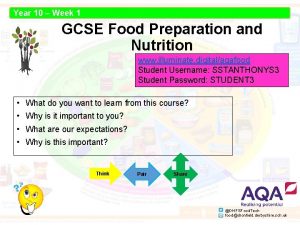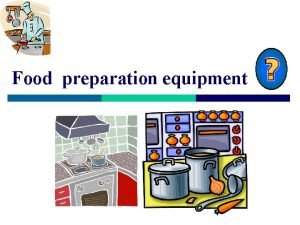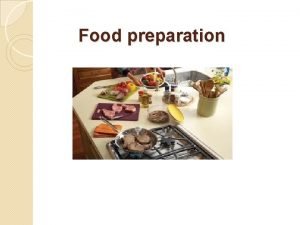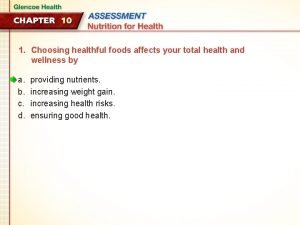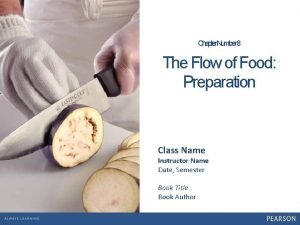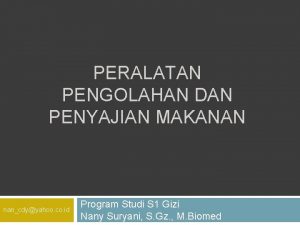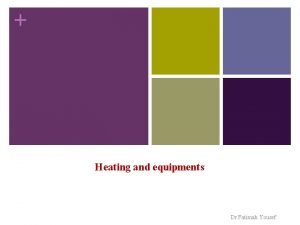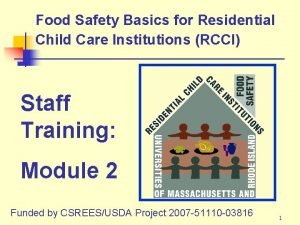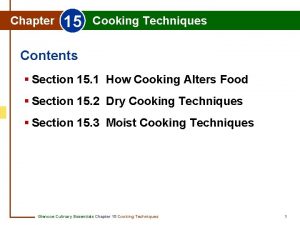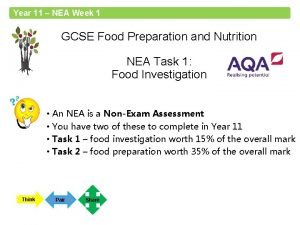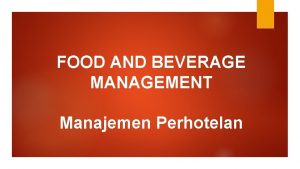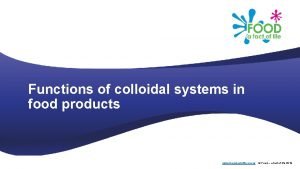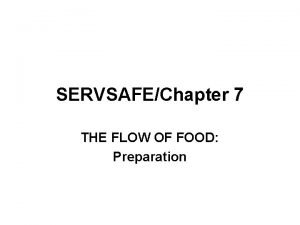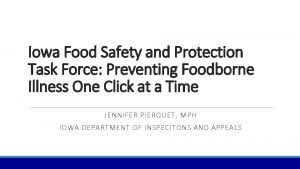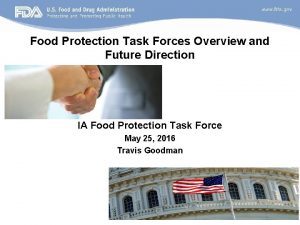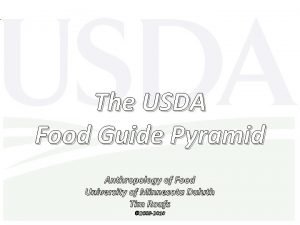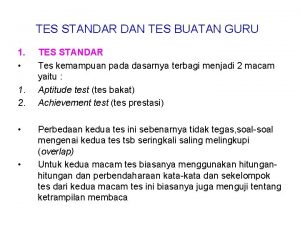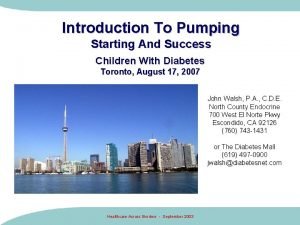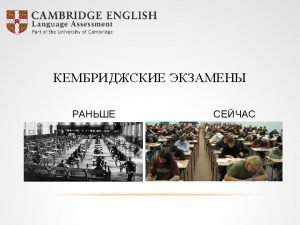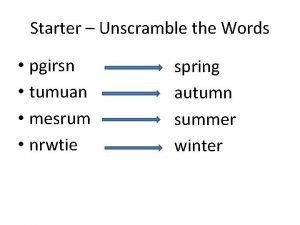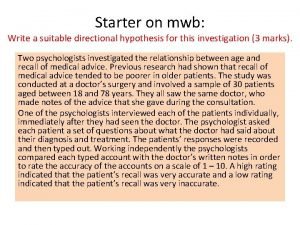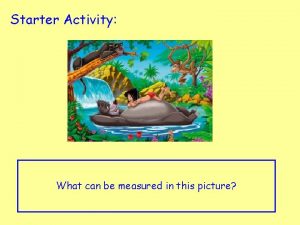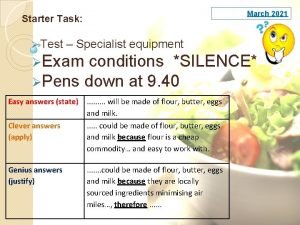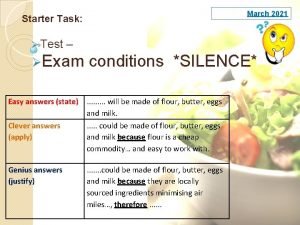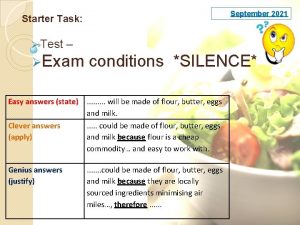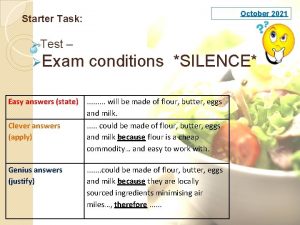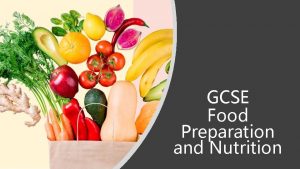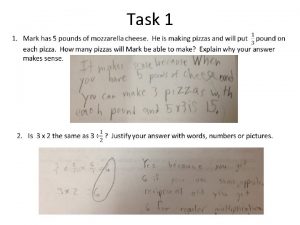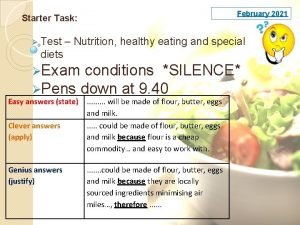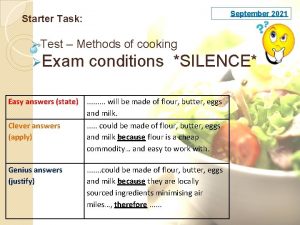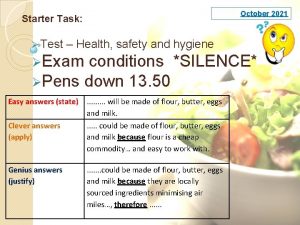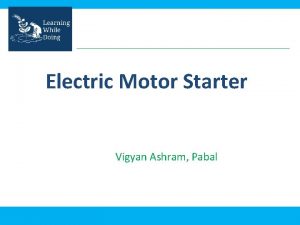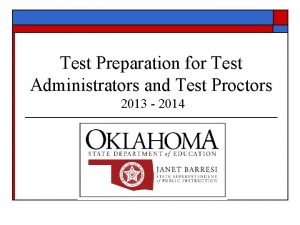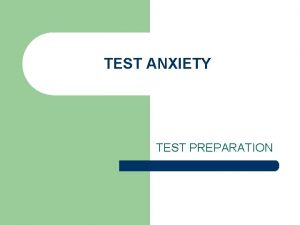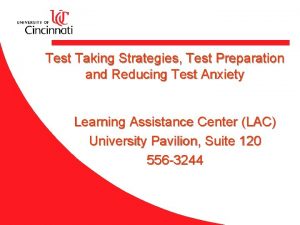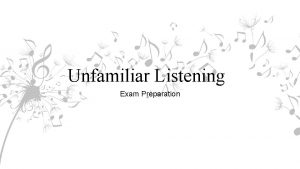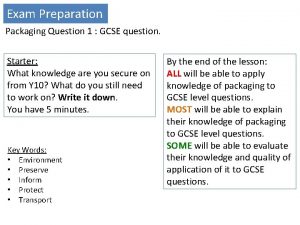March 2021 Starter Task Test Food preparation Exam














































- Slides: 46

March 2021 Starter Task: Ø Test – Food preparation ØExam conditions *SILENCE* Easy answers (state). . will be made of flour, butter, eggs and milk. Clever answers. . . could be made of flour, butter, eggs (apply) and milk because flour is a cheap commodity… and easy to work with. Genius answers (justify) . . . . could be made of flour, butter, eggs and milk because they are locally sourced ingredients minimising air miles…, therefore. . .

Lesson Objectives Healthy eating ØExplain the Eatwell plate ØDiscuss the main macro and micro nutrients ØExplain their purpose in the body ØIdentify sources available for each

Healthy eating – Eatwell plate ØYou have been approached by a local supermarket to promote healthy eating ØOn A 4 paper design your own eatwell plate poster, incorporate the following: ØMeat and fish – RDA - 2 portions ØMilk and other dairy products – RDA - 3 portions ØFruit and veg – RDA - 5 portions ØPotatoes and other starchy foods – RDA - 5 portions ØFoods high in fat and sugar – small quantities ØProvide an explanation of the benefits of eating healthily

Nutrients ØThe school canteen has approached you to help with nutrition awareness within school ØOn A 3 paper design a revision wheel/mindmap /poster for the main macro and micro nutrients ØInclude the function and sources with pictures for the following: ØMacro nutrients: Øproteins (HBV & LBV) Øfats (and oils) Øcarbohydrates – sugars and starches ØMicro nutrients: Øvitamins – A, B 1, B 2, B 3 and B 9, C and D Øminerals – calcium, iron

Nutrient Protein Function Source Growth and repair Fats and oils Warmth, energy, protects organs Carbohydrates – Starch Carbohydrates Sugar Vit A Slow release energy Meat, fish, eggs, vegetables, pulses, seeds, cereal products, soya (tvp), quorn, tofu Butter, lard, suet, vegetable plants margarines, sunflower, sesame, corn rice, potatoes, wheat, pasta Vit B 1 (Thiamin) Fast release energy Cane, beat, honey, fruit Bone growth, aids night vision and skin cells Liver, eggs, butter and fish, red orange and yellow fruit Helps the nervous system and releasing energy Green vegetables, fresh and dried fruit, eggs, from carbohydrates wholegrain breads, liver Vit B 2 (Riboflavin) Helps release energy and repair tissue Milk, eggs, cereals, rice Vit B 3 (Niacin) Vit B 9 (Folic Acid) Helps release energy Meat, fish, wheat flour, eggs, milk Vit C absorbs calcium and iron from foods, Vit D Aids absorption of calcium to produce healthy Sunshine, oily fish bones and teeth Calcium Healthy hard bones and teeth Iron Transports oxygen around the body, must have Liver, cocoa, leafy veg, dired fruit vit c present Works together with vitamin B 12 to form Green veg (broccoli, brussels sprouts, healthy red blood cells, helps to reduce the risk spinach, peas, asparagus), liver, chickpeas, of central nervous system defects, such as cereals spina bifida, in unborn babies Citrus fruits, berries, grapes tomatoes, Dairy, dark leafy products

The eatwell plate shows the recommended balance of foods in the diet.

Healthy eating Ø Nutrition links healthy eating to menu planning Ø We need to know which nutrients are in what food to eat a balanced diet Ø A balanced diet is eating a variety of foods each day from the main food groups: ØMeat and fish – 2 portions ØMilk and other dairy products – 3 portions ØFruit and veg – 5 portions ØPotatoes and other starchy foods – 5 portions ØFoods high in fat and sugar – small quantities Ø Wholegrain are also beneficial and cut down on fat, sugar and salt

The eatwell plate

The eatwell plate is based on 5 food groups. Bread, rice, potatoes, pasta and Fruit and vegetables other starchy foods Meat, fish, eggs, beans and other nondairy sources of protein Milk and dairy foods Foods and drinks high in fat and/or sugar © Food - a fact of life 2008

Fruit and Vegetables What foods are in this group? Name 6 examples. We should all aim to eat at least 5 portions everyday. Do you?

Bread, rice, potatoes, pasta Name 6 examples. We need to eat lots from this group. Try to eat food from this group at every meal time.

Milk and dairy foods This group is a good source of calcium. Eating 2 -3 portions from this group everyday can help give us all the calcium we need. Try to choose low fat foods from this group. *A portion is a small pot of yogurt, a 200 ml glass of milk or a matchbox sized piece of cheese.

Meat, fish, eggs, beans Name 5 examples. We need to eat foods from this group to stay healthy.

Foods and drinks high in fat and/or sugar Name 4 examples. We only need to eat small amounts from this group.

Meals and Dishes Much of the food eaten is in the form of dishes, combining many different food groups. Shepherd's pie Fruit and vegetables Peas and carrots Bread, rice, potatoes and pasta Mashed potatoes Milk and dairy foods Sprinkle of cheese on top Meat, fish, eggs, beans Minced beef Foods and drinks high in fat and/or sugar Oil for frying the meat

What is it made from? Breakfast Grilled bacon, poached egg, wholemeal toast, grilled mushrooms Which food groups are used? Fruit and vegetables Bread, rice, potatoes, pasta Milk and dairy foods Meat, fish, eggs, beans Foods and drinks high in fat and/sugar

What is it made from? Lunchbox Which food groups are used? Ham and salad sandwich, orange, chocolate mousse Fruit and vegetables Bread, rice, potatoes, pasta Milk and dairy foods Meat, fish, eggs, beans Foods and drinks high in fat and/sugar

What is it made from? Greek salad Which food groups are used? Lettuce, red onion, olives, cucumber, tomato, feta cheese Fruit and vegetables Bread, rice, potatoes, pasta Milk and dairy foods Meat, fish, eggs, beans Foods and drinks high in fat and/sugar

What is it made from? Chinese evening meal Which food groups are used? Sweet and sour pork, with vegetables and rice Fruit and vegetables Bread, rice, potatoes, pasta Milk and dairy foods Meat, fish, eggs, beans Foods and drinks high in fat and/sugar

Nutrients Ø The main nutrients in the body include: Øproteins (HBV & LBV) ØFats (and oils) Øcarbohydrates – sugars and starches Øvitamins – A, B group, C, D and E Øminerals – Calcium, Iron Ø Water and fibre (Non starch polysaccharide) are also important but are not classed as nutrients

Protein Ø Protein is needed for growth (especially important for children and repair of body cells and can be found in many foods: Ø Milk, yoghurt, cheese, meat, fish and eggs Ø Alternative proteins: Ø Textured Vegetable Protein (made from soya) tofu Ø Tofu – Made from soya beans Ø Quorn – Made from mushroom fungus and egg white Ø 2 types of protein: Ø High biological value - all the essential amino acids (animal and soya) Ø Low biological value - some but not all of the amino acids (peas, beans, lentils and nuts Proteins are made up of amino acids linked in a chain, when heated the chain changes its structure Ø Functions in food preparation: Ø Ø Cheese: Flavour, texture and colour, e. g. quiche, when heated forms different structure, e. g. pizza Ø Milk: Used to bind, give flavour, colour and consistency, e. g. YP, muffins Ø Yoghurt: Adds a creamy texture, thickening agent, e. g. salad dips,

Carbohydrate Ø Carbohydrates types: are energy providers, 2 ØStarch – slow release (cereals, bread, pasta, rice, potatoes) ØSugar – quick release (sugar, honey, fruit) Ø Carbohydrates break into simple sugars during the digestive process Ø Complex carbohydrates (whole grains) help stabilise blood sugar levels Ø Too much sugar will give you an energy overload, excess if not used will store as body fat

Starch Ø Obtained from cereals: Ø wheat (high) Ø maize (pure, i. e. cornflour & arrowroot) Ø Many uses: Ø Bulking – Forms the main structure, i. e. cakes, biscuits, pastry Ø Thickening – When starch is heated it absorbs and swells up until it bursts, this is called gelatinisation Ø Gelatinisation: Ø Starch when liquid is added does not dissolve, it is held in a suspension Ø If the liquid is not stirred they fall to the bottom Ø When heated, at 60° the granules start to absorb liquid Ø At 80° they start to swell, burst and thicken Ø At 100° gelatinisation is complete Ø When cooled it sets to form a gel, e. g. blancmanges, lemon curd Ø Modified starches – Altered starch to thicken when boiling or cold water is added

Heat starch granules in liquid Starch granules burst Starch granules become swollen The liquid thickens and gelatinizes Starch gelatinizes when heated in a liquid, producing a thickened liquid

Sugar Ø Comes from sugar beet or sugar cane ØSugar beet – grows in cool countries (here), sugar stored in the root ØSugar cane – grows in tropical countries, sugar stored in the can as juice Ø There are many types used in food: ØGranulated - General purpose, i. e. tea, breakfast ØCastor – Fine crystals used in baking when a fine texture is needed and dissolve quickly ØDemerara – Large crystals with a strong flavour used for pudding toppings ØMuscovado – Dark sticky crystals used in fruit cakes and gingerbread ØIcing – White powder that dissolves quickly, used for icing

Fats and oils Ø Fats are solid at room temperature (butter, margarine, lard) Ø Oils are liquid (corn, sunflower, sesame oil) Ø Fats provide energy and body warmth Ø Fats from animals are known as saturated (bad), fats from fish are known as Omega 3, 6 and 9 all excellent for your brain and heart (good), Fats from vegetable sources are unsaturated (good) Ø The same weight of fat gives twice as many calories as carbohydrates Ø Too much fat can cause: Ø Obesity Ø High cholesterol (fatty bits clotting arteries) Ø CHD (coronary heart disease) Ø Halitosis (bad breath) Ø Type 2 diabetes

Fats and oils Ø There are 6 main types: ØButter – Made form churning cream ØMargarine – Made from vegetable oil blended with water, emulsified using modified starch – high water content – not great for baking ØLard – Made from pig fat ØSuet – Made from fat which protects animal organs ØOils – Pressed seeds (sunflower, rape) ØLow fat spreads – Emulsions from vegetable oils (hydrogenated making them more solid) – high water content - not great for baking Ø Saturated – Mainly from animal sources and are mainly solid at room temp Ø Unsaturated – Mainly from vegetable sources and are usually liquid (oils)

Fats and oils Ø Functions of fats and oils: ØAdding flavour and colour, e. g. butter in shortbread ØShortening, e. g. when fat is coats the flour particles preventing the absorption of water resulting in a crumbly texture, this process stops the gluten (protein found in flour) developing ØAdding colour, e. g. butter in pastry makes the pastry golden yellow ØAerate – when creamed with sugar it helps trap air ØExtend shelf life ØFlaky texture to pastries ØEmulsion – When mixed with liquids ØPrevents lumps forming, e. g. white sauce

Fats and oils Ø Functions of fats and oils: ØAdding flavour and colour, e. g. butter in shortbread ØShortening, e. g. when fat is coats the flour particles preventing the absorption of water resulting in a crumbly texture, this process stops the gluten (protein found in flour) developing ØAdding colour, e. g. butter in pastry makes the pastry golden yellow ØAerate – when creamed with sugar it helps trap air ØExtend shelf life ØFlaky texture to pastries ØEmulsion – When mixed with liquids ØPrevents lumps forming, e. g. white sauce

Vitamins Vital for good health Vitamin A (retinol) (fat soluble) – helps to see in dim light, healthy skin and tissue - liver, eggs, butter, soft spread. Orange and yellow veg contain carotenoid substances which can be converted into retinol Ø Vit B Group (water soluble): Ø Ø Ø B 1 (thiamine) - Helps the nervous system and releasing energy from carbohydrates - Green vegetables, fresh and dried fruit, eggs, wholegrain breads, liver Ø B 2 (riboflavin) - Helps release energy and repair tissue - Milk, eggs, cereals, rice Ø B 3 (niacin) - Helps release energy - Meat, fish, wheat flour, eggs, milk Ø B 9 (folic acid) - Crucial for growth and vital for pregnancy cereals, liver, kidney, peas, pulses, dairy, meat and fish Ø B 12 (cobalamin) - Making red blood cells and keeping the nervous system healthy, releasing energy from the food we eat,

Vitamins Vitamin C (ascorbic Acid) (water soluble) – Healthy skin, helps heal faster and absorb iron - citrus fruits Ø Vitamin D (calciferols )(fat soluble) – Growth and maintenance of strong bones (helps absorb calcium) lack of it causes bone diseases (rickets, osteoporosis) - oily fish and eggs and sunlight Ø Vitamin E (tocopherols )(fat soluble) - involved in certain cell metabolic reactions, widely distributed in small amounts in foods, particularly found in wheat germ and some vegetable oils Ø

Minerals Calcium - Healthy bones and teeth, nerves and muscles and blood clotting, works with vit D and phosphorous, lack of can lead to osteoporosis (brittle bone disease) - milk, salmon, green leafy veg, white bread Ø Iron – Formation of red blood cells, lack of iron causes anaemia (more common with teenage girls) - red meat, dark green vegetables, eggs, dried fruit Ø

Water and fibre Ø 65% for: of the body weight is water, needed ØControl body temperature ØLubricate joints ØHelp digestion ØRemove waste ØAdults need 2 ½ litres per day Ø NSP (non starch polysaccharide) is the cellulose, the non digestible material found in plants which pulls out all the roughage, it also absorbs water, lack of fibre will cause constipation Ø Lack of fibre can cause cancer of the

Healthy eating Ø The eatwell plate is based upon 8 Government guidelines for a healthy diet: ØBase your meals on starchy foods ØEat lots of fruit and vegetables ØEat more fish (1 portion of oily fish a week) ØCut down on saturated fat and sugar ØTry to eat less salt ØGet active and try to be a healthy weight ØDrink plenty of water ØDon’t skip breakfast

Healthy eating Ø Research has shown there are many links to modern diseases through a poor diet: Ø Too much fat can cause heart disease Ø Too much sugar may cause tooth decay and diabetes (type 2) Ø Too much salt may cause high blood pressure Ø Lack of fibre may cause bowel cancer and constipation Ø Too much fat, sugar and too little fibre may cause obesity which also have links to diabetes, strokes and high blood pressure Ø Smoking and drinking alcohol can also increase the risk of illness and early death Most of our calories should could from complex carbohydrates (bread, pasta, rice potatoes), these foods are also low in fat and high in vitamins and minerals, protein should come from low fat sources (lean meat, fish, chicken, turkey rather than full dairy products Ø Fruit and veg are a key source of vitamins and minerals Ø

Fat Ø Fat comes from many sources including: ØMeat and meat products ØSpreading fats ØMilk, cheese and cream ØCooking fats and oils Ø Ways of achieving lower fat content include: ØCutting visible fat off ØSmaller leaner portions ØLow fat or polyunsaturated spreads ØUsing vegetable fats ØReducing fat content ØCutting bread and chips thicker to minimise fat coverage ØUsing soya products ØOffering oily fish rich in Omega 3

Sugar Ø Sugar provides ‘empty calories’ but taste nice and is addictive, we could: ØUse sugar substitutes ØOffer fresh fruit only instead of desserts ØUsing tinned fruit in natural juices ØOffer low calorie soft drinks

Salt Ø We can reduce the amount of salt we consume by: ØReducing the amount in cooking ØCutting down on convenience foods ØCutting down on crisps, nuts and nibbles

Fibre Ø 2 types: Ø Soluble – lowers cholesterol, found in peas, beans, lentils, pectin rich fruits like apples, cranberries and citrus fruits Ø Insoluble (acts like a sponge) – helps to keep poo soft, found in wholegrain wholewheat, wholemeal cereals (bran) Ø Caters can increase fibre by: ØOffering wholemeal bread and cereals ØOffering wholewheat pasta ØServing fruit and veg with skin on ØAdding rolled oats to crumble toppings ØUsing wholemeal flour

Lesson Objectives Special diets ØList various special diets ØExplain their purpose ØEvaluate their requirements ØDiscuss obesity

Special diets Ø Some choose not to eat certain foods for a variety of reasons: ØEthical beliefs ØReligious beliefs ØMedical reasons ØDislike taste or texture Ø Vegetarians – many people choose a vegetarian diet: ØStrong feelings about the way animals are slaughtered ØLand used to feed animals could be used for crops ØMany cases of food poisoning are linked to animals ØA vegetarian diet is considered healthier (lower

Special diets Ø Several types: Ø Vegan – No red or white meat, fish or poultry or byproducts Ø Lacto vegetarian – No red or white meat, fish, poultry or eggs Ø Ovo vegetarian – No red or white meat, fish or poultry or dairy but eat eggs Ø Lacto-ovo vegetarian – No red or white meat, fish or poultry, eat dairy and eggs Pollotarian – No red meat or fish but will eat white meat Ø Pescatarian – fish only Ø Medical diets include: Ø Ø Coeliac - Can’t eat gluten (wheat, barley and rye), they have to get starch and fibre from other sources e. g. rice, potatoes or gluten free products Ø Lactose intolerance - Unable to digest lactose (sugar found in milk), can eat cheese, soya and yoghurt though

Special diets ØCalorie controlled diets – Overweight and need to watch their calorie intake. Fat and sugar provide a lot of calories without filling you up. Starchy products should be eaten in moderation to fulfill the day’s activities ØNut allergies – Need to avoid products containing nuts and traces – warnings should be visible on the packaging ØDiabetics – Unable to control their blood sugar levels and need to avoid sugary foods, they need to eat plenty of starchy products which release energy

Special diets Ø Religious diets include: ØMuslims – do not eat pork (unclean), shellfish or drink alcohol, meat has to be slaughtered in a certain way (Halal) ØHindus – do not eat beef (sacred) ØSikhs – eat all types of meat ØJews – do not eat pork, bacon, ham, shellfish or eels, do not eat milk and meat at the same time (lasagne), they eat kosher meat (prepared a certain way) ØRastafarians – do not eat processed foods, pork or eels or drink alcohol, tea or coffee

Obesity Ø What is obesity? Ø People with a BMI of 30 are termed obese Ø BMI = weight (in kg) divided by height (in meters) squared ØScenario: height 1. 5 weighs 50 kg 50 / (1. 5 x 1. 5 = 2. 25) = 22 Ø Task: calculate your own BMI

Obesity is caused by not using the calories we eat Ø Fat is stored as an energy reserve under the skin or around vital organs, they look like tiny plastic bags building up Ø Medical problems linked to obesity include: Ø Ø High cholesterol levels Ø CHD Ø Gallbladder problems Ø Strokes Ø Osteoarthritis Ø Breathing problems Ø Type 2 diabetes Ø Stres Ø Some cancers Ø Homework: Complete revision material/revise for test
 Anthem of poland
Anthem of poland Starter task
Starter task Key time cambridge
Key time cambridge Weekly current events quiz
Weekly current events quiz March 5 2021
March 5 2021 Starter draw test
Starter draw test What is career investigation
What is career investigation Preparation tasks
Preparation tasks Preparation task
Preparation task Tiered task bias task
Tiered task bias task Unit 2 food food food
Unit 2 food food food Grazing food chain diagram
Grazing food chain diagram Bcse exam preparation
Bcse exam preparation Mext exam preparation
Mext exam preparation Short task writing
Short task writing Creative arts term 3
Creative arts term 3 Nbme shelf exam percentiles 2021
Nbme shelf exam percentiles 2021 Ap biology score
Ap biology score Illuminate aqa food
Illuminate aqa food Primary equipment in cooking
Primary equipment in cooking Definition of food preparation
Definition of food preparation Your body uses carbohydrates by breaking them down into
Your body uses carbohydrates by breaking them down into Flow of food: preparation
Flow of food: preparation Alat penyajian adalah
Alat penyajian adalah Used to measure heat intensity in food preparation
Used to measure heat intensity in food preparation Purpose of food safety
Purpose of food safety To cook food directly under a primary heat source
To cook food directly under a primary heat source Aqa food tech nea 2 example
Aqa food tech nea 2 example F&b cycle
F&b cycle Mayonnaise is a colloid
Mayonnaise is a colloid The flow of food preparation
The flow of food preparation Food preparation activities
Food preparation activities Iowa food protection task force
Iowa food protection task force Iowa food protection task force
Iowa food protection task force Tnwic
Tnwic Usda food pyramid 1992
Usda food pyramid 1992 Contoh tes buatan guru
Contoh tes buatan guru Eqao sample tests grade 3
Eqao sample tests grade 3 Test cavity preparation
Test cavity preparation Glycomark test preparation
Glycomark test preparation Starters movers flyers ket pet fce cae
Starters movers flyers ket pet fce cae Pictogram starter
Pictogram starter Reichstag fire who was the fire starter
Reichstag fire who was the fire starter Starter unscramble
Starter unscramble Example directional hypothesis
Example directional hypothesis Starter background
Starter background Abiotic factors clipart
Abiotic factors clipart




